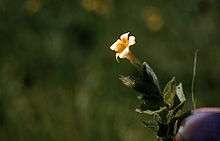Mimulus moschatus
| Mimulus moschatus | |
|---|---|
 | |
| Scientific classification | |
| Kingdom: | Plantae |
| (unranked): | Angiosperms |
| (unranked): | Eudicots |
| (unranked): | Asterids |
| Order: | Lamiales |
| Family: | Phrymaceae |
| Genus: | Mimulus |
| Species: | M. moschatus |
| Binomial name | |
| Mimulus moschatus Dougl. ex Lindl. | |
Mimulus moschatus is a species of monkeyflower known by the common names muskflower, musk monkeyflower, and formerly as the common musk, eyebright and musk plant.
Distribution
It is native to western North America from British Columbia to California to the Rocky Mountains, where it grows in moist, partially shaded habitat in mountains, woodlands, chaparral, and other areas.
It also occurs in eastern North America where it may be native or introduced.[1] It is known from Chile and parts of Europe, including England and Finland, where it grows wild after having escaped cultivation.[2]
Description
This is a rhizomatous perennial herb which is hairless to hairy, sometimes slimy in texture, and generally musky in scent. It is variable in appearance. The prostrate or upright stem grows up to 30 centimeters long. The oppositely arranged leaves are mostly oval in shape and may reach 6 centimeters long. The tubular flower is yellow in color, its tube just a few millimeters wide and widening at the lobed mouth. It may be up to 2.6 centimeters long.
Loss of scent
Mimulus moschatus was widely grown and sold commercially in Victorian times for its fragrance, and is well-known for the story that all cultivated and known wild specimens simultaneously lost their previous strong musk scent around the year 1913.[3] Writing in 1934 in the journal Nature, E. Hardy described a Lancashire nurseryman, Thomas Wilkinson, who in 1898 found that his plants developed a "rank, leafy smell"; five years later, after leaving the trade, he noticed that plants then on sale were scentless.[4] While it was sometimes claimed that strongly scented plants could still be found in the wild, Arthur William Hill, in a 1930 article in The Gardeners' Chronicle, presented evidence from British Columbia claiming that wild populations had also lost their scent.
A variety of suggestions were put forward for a solution to the mystery, such as that the scent of the original cultivated form had been a rare recessive feature, which later disappeared as a result of uncontrolled pollination or the introduction of other genes from the wild population. Other explanations were given based on changes in climate, that humans had lost the ability to detect the smell, that the scent had been produced by a parasite, or simply that the loss of scent was a myth. W.B. Gourlay (1947) suggested that the phenomenon could be explained if the highly scented cultivated form had been reproduced vegetatively from a single aberrant plant, first raised in England from the original batch of seed, and subsequently replaced by unscented plants grown from other sources of seed.[5] It is notable that Douglas, who first described the species and collected seed in 1826 near Fort Vancouver from which the first examples in England were raised, made no reference to a strong musk scent in his field notes.[6] Moreover there are references as early as 1917 to plants in the wild having a wide range of characteristics between scentless and strongly scented, with the latter being "very much the exception".[7] During the 1920s and 1930s, at the height of botanists' interest in the 'lost scent' phenomenon, there were several reports of strongly-scented moschatus specimens being discovered in the wild, such as in 1931 on Texada Island, British Columbia.
References
- ↑ Ewing, B. C. (2001). New England Plant Conservation Program Conservation and Research Plan: Mimulus moschatus
- ↑ Hear.org Reports
- ↑ See correspondence in The Gardeners' Chronicle vols. 75: 78 (1924), 88: 259, 349, 399, 457, 520 ( 1930), and 89: 17, 36, 116, 190, 202, 207 (1931)
- ↑ Hardy, "Lost Fragrance of Musk", Nature, v 134 (1934), 3383, 327
- ↑ Gourlay, W. B. "The lost scent of Mimulus moschatus". J R. Hort. Soc. 72, 285-287
- ↑ Gardening Illustrated, v.65, (1948), 6
- ↑ See Journal of Botany, British and Foreign, v.55 (1917), 260-261